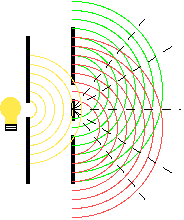Double Slit Interference
One of the first experiments to demonstrate the wave nature of
light was carried out by Thomas Young in 1800. This experiment
involved illuminating two small slits with light from a single
source. In the drawing below, the light bulb and slit with single
hole represent a coherent light source (yellow lines). In coherent
light all waves have the same phase and wavelength. This light is
incident on two small slits. Both the slit size and the distance
between the two slits are the same order of magnitude as the
wavelength of light. Each of the two slits acts as a source of light
waves (red and green lines) - each of the slits is a new "point
source," light expands spherically from point sources.
 At any
given point to the right of the double slits, light waves originating
from each of the slits will have to travel a given distance from the
center of the slit. A different distance of travel implies a
different relative phase between the two light waves. When the
relative phase is a multiple of the wavelength, constructive
interference will occur. Along the dashed lines in the drawing,
constructive interference will take place. When the relative phase is
a multiple of the wavelength plus half the wavelength, destructive
interference occurs.
At any
given point to the right of the double slits, light waves originating
from each of the slits will have to travel a given distance from the
center of the slit. A different distance of travel implies a
different relative phase between the two light waves. When the
relative phase is a multiple of the wavelength, constructive
interference will occur. Along the dashed lines in the drawing,
constructive interference will take place. When the relative phase is
a multiple of the wavelength plus half the wavelength, destructive
interference occurs.
©
MultiMedia
Physics
2000
 At any
given point to the right of the double slits, light waves originating
from each of the slits will have to travel a given distance from the
center of the slit. A different distance of travel implies a
different relative phase between the two light waves. When the
relative phase is a multiple of the wavelength, constructive
interference will occur. Along the dashed lines in the drawing,
constructive interference will take place. When the relative phase is
a multiple of the wavelength plus half the wavelength, destructive
interference occurs.
At any
given point to the right of the double slits, light waves originating
from each of the slits will have to travel a given distance from the
center of the slit. A different distance of travel implies a
different relative phase between the two light waves. When the
relative phase is a multiple of the wavelength, constructive
interference will occur. Along the dashed lines in the drawing,
constructive interference will take place. When the relative phase is
a multiple of the wavelength plus half the wavelength, destructive
interference occurs.